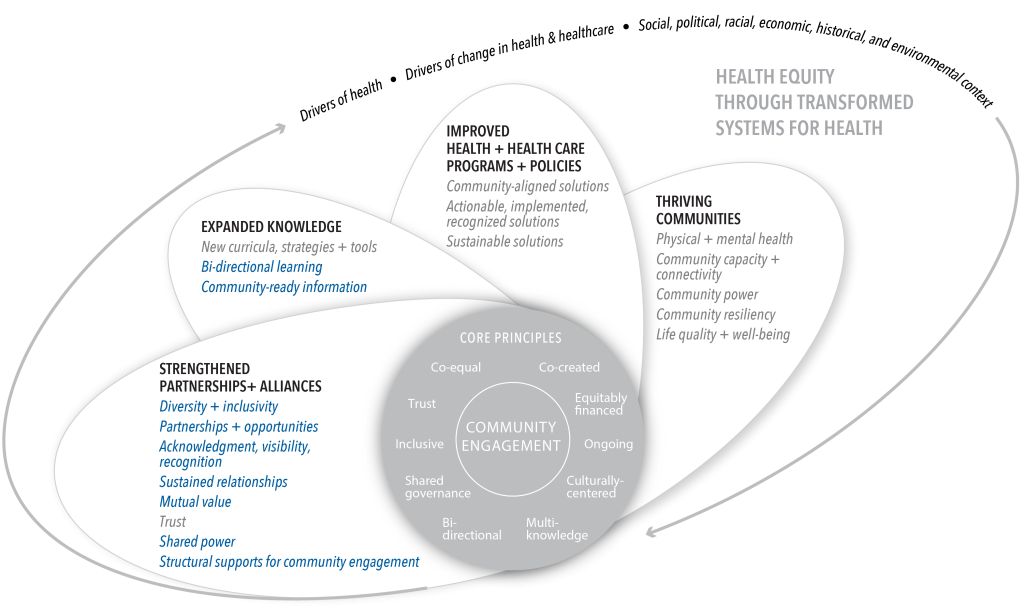Community Engagement Measure
KEY FEATURES
COMMUNITY/ GEOGRAPHY
African American women
Community-academic partnerships
Cancer disparities elimination
United States
COMMUNITY ENGAGEMENT OUTCOMES
Strengthened partnerships + alliances
Diversity + inclusivity
Partnerships + opportunities
Acknowledgment, visibility, recognition
Sustained relationships
Mutual value
Shared power
Structural supports for community engagement
Expanded knowledge
Bi-directional learning
Community-ready information
PLACE(S) OF INSTRUMENT USE
Academic/research institution/university
Community/community-based organization
LANGUAGE TRANSLATIONS
Not specified
PSYCHOMETRIC PROPERTIES
Internal consistency reliability
YEAR OF USE
Not specified
Assessment Instrument Overview
The Community Engagement Measure1,2 has 48 questions and is used by community-academic partnerships. It assesses the quality and quantity of levels of engagement among community members in the partnerships. The Community Engagement Measure was used in the development of another instrument: Research Engagement Survey Tool.
Alignment with Assessing Meaningful Community Engagement Conceptual Model
The questions from the Community Engagement Measure were realigned to the Assessing Community Engagement Conceptual Model. Figure 1 displays the alignment of the Community Engagement Measure with the Conceptual Model domain(s) and indicator(s).
Table 1 displays the alignment of the Community Engagement Measure’s individual questions with the Conceptual Model domain(s) and indicator(s). The table shows, from left to right, the aligned Conceptual Model domain(s) and indicator(s) and the individual questions from the Community Engagement Conceptual Model transcribed as they appear in the instrument (with minor formatting changes for clarity).
CONCEPTUAL MODEL DOMAIN(S) AND INDICATOR(S) | ASSESSMENT INSTRUMENT QUESTIONS |
STRENGTHENED PARTNERSHIPS + ALLIANCES; Diversity + inclusivity | Please rate how often/how well you think the academic team did each of the following:
|
STRENGTHENED PARTNERSHIPS + ALLIANCES; Partnerships + opportunities | Please rate how often/how well you think the academic team did each of the following:
|
STRENGTHENED PARTNERSHIPS + ALLIANCES; Acknowledgment, visibility, recognition | Please rate how often/how well you think the academic team did each of the following:
|
STRENGTHENED PARTNERSHIPS + ALLIANCES; Sustained relationships | Please rate how often/how well you think the academic team did each of the following:
|
STRENGTHENED PARTNERSHIPS + ALLIANCES; Mutual value | Please rate how often/how well you think the academic team did each of the following:
|
STRENGTHENED PARTNERSHIPS + ALLIANCES; Shared power | Please rate how often/how well you think the academic team did each of the following:
|
STRENGTHENED PARTNERSHIPS + ALLIANCES; Structural supports for community engagement | Please rate how often/how well you think the academic team did each of the following:
|
EXPANDED KNOWLEDGE; Bi-directional learning | Please rate how often/how well you think the academic team did each of the following:
|
EXPANDED KNOWLEDGE; Community-ready information | Please rate how often/how well you think the academic team did each of the following:
|
Not aligned with Conceptual Model | Please rate how often/how well you think the academic team did each of the following: Plan for ongoing problem solving. |
Table 1 | Community Engagement Measure questions and alignment with the domain(s) and indicator(s) of the Assessing Community Engagement Conceptual Model
ASSESSMENT INSTRUMENT BACKGROUND
Context of instrument development/use
The article discusses leveraging the existing yet limited quantitative measures of community engagement in public health research to develop a new measure – the Community Engagement Measure – to assess the level of engagement among community members in community-academic partnerships. The Community Engagement Measure provides scores on the overall engagement of people in the project and has the ability to differentiate the level of engagement among groups. The Community Engagement Measure was used to evaluate the Program for the Elimination of Cancer Disparities (PECaD) at the Siteman Cancer Center (a National Cancer Institute designated Comprehensive Cancer Center), “a national model for eliminating disparities in cancer through community-based partnerships.” The Community Engagement Measure examines engagement longitudinally and over a continuum. It can be used to monitor and improve partnerships and explore how partnerships facilitate outcomes.2
Instrument description/purpose
The Community Engagement Measure reviews 11 engagement focus areas that are based on community engaged research (CER):
- Focus on local relevance and social determinants of health
- Acknowledge the community
- Disseminate findings and knowledge gained to all partners
- Seek and use the input of community partners
- Involve a cyclical and iterative process in pursuit of objectives
- Foster co-learning, capacity building, and co-benefit for all partners
- Build on strengths and resources within the community
- Facilitate collaborative and equitable partners
- Integrate and achieve a balance of all partners
- Involve all partners in the dissemination process
- Plan for a long-term process and commitment evaluation, marketing and communication, programs, staff, partnerships, funding.
The Community Engagement Measures uses 48 questions to evaluate quality of the engagement using a five-point Likert scale with response options ranging from “poor” to “excellent.” The same 48 questions evaluate quantity (i.e., how often engagement took place) using a five-point Likert scale with responses options ranging from “never” to “always.” In the article, the range and mean scores across each of the focus areas were examined.2
The Community Engagement Measure can be found here: https://doi.org/10.1002/jcop.21828.
Engagement involved in developing, implementing, or evaluating the assessment instrument
The PECaD was created to address cancer health disparities through community-based partnerships. The PECaD worked closely with the Disparities Elimination Advisory Committee (DEAC) “comprising community leaders representing Federally Qualified Health Centers; private physicians; health, social service, and religious organizations; survivors; survivors’ family members; and other interested community groups.” The DEAC was involved in and guided the engagement of the PECaD in health promotion and education efforts to address “barriers to cancer screening, treatment, and research participation in the region.” “The PECaD survey development team included research and DEAC community members: three PECaD investigators, the PECaD data manager, PECaD program coordinator, and the DEAC community co-chair.” Input from the DEAC helped to shape the evaluation framework, the principles that should guide CER, levels of community member participation, and activities to ensure continuous community member participation. “The PECaD survey development team developed items (the Community Engagement Measure) aligned with the 11 [engagement principles] to assess the level of community engagement in PECaD projects and worked with DEAC in a cyclical and iterative community-engaged process.”2
Additional information on populations engaged in instrument use
The Community Engagement Measure was tested by 47 participants in the Community Research Fellows Training (CRFT) program, a pilot project of the PECaD. Of those who completed the measure (46; 98%), the majority were female (85%), African American/Black (87%), earned a graduate degree (52%), and considered themselves to be a community member or affiliated with a community-based organization (54%).2
Notes
- Potential limitations: While the engagement principles are generalizable to other diseases and populations, the community engagement measure, as tested among the CRFT participants, a largely female and African American sample, “may not be generalizable to other populations.”2
- Important findings: CRFT participants felt that academic partners adhered to the quality scale of the 11 engagement focus areas between “good” and “very good” and for the quantity scale between “sometimes” and “most of the time”. The engagement focus area of “cyclical and interactive process in the pursuit of objectives” received the lowest rating on the quantity scale. The engagement focus area of “plan for a long-term process and commitment” received the lowest rating on the quality scale. The engagement focus area of “local relevance and social determinants of health” received high ratings on both quantity and quality scales. These results demonstrate where improvement in the partnership is needed.2
- Future research needed: Future research would benefit from testing the measure with different populations, including better understanding of “participants’ reactions and thought processes when exposed to items measuring the quality and quantity of community engagement in research.”2
We want to hear from you!
Assessing community engagement involves the participation of many stakeholders. Click here to share feedback on these resources, or email [email protected] and include “measure engagement” in the subject line to learn more about the NAM’s Assessing Community Engagement project.
Related Products


